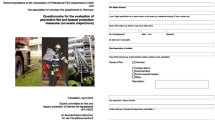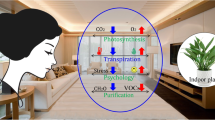Abstract
Cooking activity is accompanied with several risks, mainly for elderly people due to attention and memory impairment. Literature reveals that the kitchen is the second most common place for domestic accidents. We argue that enhancing safety during cooking activities could be achieved via designing a cooking-safe environment based on insightful risk analysis and assessment study. This paper presents our study on risk analysis and assessment during cooking, in order to build a cooking-safe environment. The study is based on theoretical and real-world experimentations. Risk analysis and assessment enabled us to determine the three major risks (i.e., fire, burn and intoxication by gas/smoke) and the pertinent parameters to quantify these risks. The results reveal that the pertinent parameters are: concentrations of volatile organic compounds, alcohol, and carbon monoxide gases in the cooking smoke, utensil temperature, burner temperature, relative humidity, and presence of a utensil on burner. We present in details our study on risk analysis and assessment, including the methodology and the findings.











Similar content being viewed by others
References
Yared R, Abdulrazak B (2016) Ambient technology to assist elderly people in indoor risks. Computers 5:22
Yared R, Mallat H, Abdulrazak B (2015) Ambient technology to support elderly people in outdoor risk situations. In: Helfert M, Holzinger A, Ziefle M, Fred A, O’Donoghue J, Röcker C (eds) Communications in computer and information science, vol 578. Springer, Berlin, pp 35–56
Mallat H, Yared R, Abdulrazak B (2015) Assistive technology for risks affecting elderly people in outdoor environment. In: International conference on information and communication technologies for ageing well and e-health, ICT4AgeingWell, pp 5–16
Ahrens M (2008) Home smoke alarms: the data as context for decision. Fire Technol 44(4):313–327
Office of the Fire Marshal - Ministry of Community Safety and Correctional Services (2009) Reducing residential stovetop fires in Ontario
Lushaka B, Zalok E (2014) Development of a sensing device to reduce the risk from kitchen fires. Fire Technol 50(3):791–803
Hall JR (2006) Home cooking fire patterns and trends. National Fire Protection Association, Quincy
Yared R, Abdulrazak B, Tessier T, Mabilleau P (2015) Cooking risk analysis to enhance safety of elderly people in smart kitchen. In: Proceedings of the 8th ACM international conference on PErvasive technologies related to assistive environments—PETRA’15
Yared R, Abdulrazak B (2015) Toward context-aware smart oven to prevent cooking risks in kitchen of elderly people. In: Communications in computer and information science, CCIS, vol 578. Springer International Publishing, Switzerland, pp 57–77
Abdulrazak B, Yared R, Tessier T, Mabilleau P (2015) Toward pervasive computing system to enhance safety of ageing people in smart kitchen. In: ICT4AgeingWell 2015—International conference on information and communication technologies for ageing well and e-health, pp 17–28
Omaki E, Shields WC, Frattaroli S, McDonald E, Jones V, Gielen A (2017) Six-month follow-up of lithium-battery smoke alarms and self-reported reasons for disabling. Inj Prev 23(1):67–69
World Health Organisation (2012) Interesting facts about ageing. WHO, Geneva
Marzocchi W, Garcia-Aristizabal A, Gasparini P, Mastellone ML, Di Ruocco A (2012) Basic principles of multi-risk assessment: a case study in Italy. Nat Hazards 62(2):551–573
Kaplan S, Garrick BJ (1981) On the quantitative definition of risk. Risk Anal 1(1):11–27
Wijayasinghe M, Makey T (1997) Cooking oil: a home fire hazard in Alberta, Canada. Fire Technol 33:140–166
Nagashima T, Mammoto A, Yamauchi Y, Watanabe K (1988) Optimization of sensitivity characteristics of photoelectric smoke detector to various smokes. Fire Saf Sci 3:319
Cleary T (2014) Performance of dual photoelectric/ionization smoke alarms in full-scale fire tests. Fire Technol 50(3):753–773
Chen S, Bao H, Zeng X, Yang Y (2003) Research of fire detection method based on multi-sensor data fusion. In IEEE international conference on computational intelligence and software engineering CiSE, vol 4, pp 3775–3780
Milke JA, Hulcher ME, Worrell CL, Gottuk DT, Williams FW (2003) Investigation of multi-sensor algorithms for fire detection. Fire Technol 39(4):363–382
Hagen B, Milke J (2000) The use of gaseous fire signatures as a mean to detect fires. Fire Saf J 34:55
Johnsson E (1995) Study of technology for detecting pre-ignition conditions of cooking-related fires associated with electric and gas ranges and cooktops. Final report
Milke JA, McAvoy TJ (1995) Analysis of signature patterns for discriminating fire detection with multiple sensors. Fire Technol 31(2):120–136
Bashyal S, Venayagamoorthy GK, Paudel B (2008) Embedded neural network for fire classification using an array of gas sensors. In: 2008 IEEE sensors applications symposium
Charumporn B, Yoshioka M, Fujinaka T, Omatu S (2003) Early stage fire detection using reliable metal oxide gas sensors and artificial neural networks. In: Proceedings of the international joint conference on neural networks, vol 4, pp 3185–3188
Yuan MY, Green JR, Goubran R (2013) Thermal imaging for assisted living at home: Improving kitchen safety. J Med Biol Eng 33(4):380–387
Runyan C, Casteel C, Perkis D, Black C (2005) Unintentional injuries in the home in the United States: part I: mortality. Am J Prev Med 28:73
Ho C-T, Shahidi F (2005) Flavor components of fats and oils. In: Bailey’s Industrial Oil and Fat Products, vol 1, pp 387–411
Evans GJ, Peers A, Sabaliauskas K (2008) Particle dose estimation from frying in residential settings. Indoor Air 18(6):499–510
Jiang X, Zhu S, Wu Y, Huai H (2009) The effects of cooking oil fume condensates (COFCs) on the vegetative growth of Salvinia natans (L.) All. J Hazard Mater 172(1):240–246
Liu Z, Kim AK, Carpenter D, Kanabus-Kaminska JM, Yen PL (2004) Extinguishment of cooking oil fires by water mist fire suppression systems. Fire Technol 40(4):309–333
Fennema OR (1996) Food chemistry, 3rd edn. CRC Press, Boca Raton
Rogge WF, Hildemann LM, Mazurek MA, Cass GR, Simonelt BRT (1991) Sources of fine organic aerosol. 1. Charbroilers and meat cooking operations. Environ Sci Technol 25(6):1112–1125
Varghese SK, Gangamma S, Patil RS, Sethi V (2005) Particulate respiratory dose to indian women from domestic cooking. Aerosol Sci Technol 39(12):1201–1207
Zhao Y, Hu M, Slanina S, Zhang Y (2007) Chemical compositions of fine particulate organic matter emitted from Chinese cooking. Environ Sci Technol 41(1):99–105
Svedahl S, Svendsen K, Qvenild T, Sjaastad AK, Hilt B (2009) Short term exposure to cooking fumes and pulmonary function. J Occup Med Toxicol 4:9
Turner DG, Leman CJ, Jordan MH (1989) Cooking-related burn injuries in the elderly preventing the ‘granny gown’ burn. J Burn Care Rehabil 10(4):356–359
Lewandowski R, Pegg S, Fortier K, Skimmings A (1993) Burn injuries in the elderly. Burns 19(6):513–515
Moritz AR, Henriques FC (1947) Studies of thermal injury: the relative importance of time and surface temperature in the causation of cutaneous burns. Am J Pathol 23:695–720
Barsan ME (2007) National Institute for Occupational Safety and Health (NIOSH). Pocket guide to chemical hazards. Report no 2005-149
Weaver LK (2009) Carbon monoxide poisoning. N Engl J Med 360:1217–1225
Prockop LD, Chichkova RI (2007) Carbon monoxide intoxication: an updated review. J Neurol Sci 262(1–2):122–130
Acknowledgements
We are grateful to all our students who have participated in this project. In particular, Camille Goujeau and Thomas Tessier for their excellent work. We are also grateful to the anonymous reviewers for their valuable reviews that helped improve the paper.
Author information
Authors and Affiliations
Corresponding author
Rights and permissions
About this article
Cite this article
Yared, R., Abdulrazak, B. Risk Analysis and Assessment to Enhance Safety in a Smart Kitchen. Fire Technol 54, 555–577 (2018). https://doi.org/10.1007/s10694-017-0696-5
Received:
Accepted:
Published:
Issue Date:
DOI: https://doi.org/10.1007/s10694-017-0696-5




